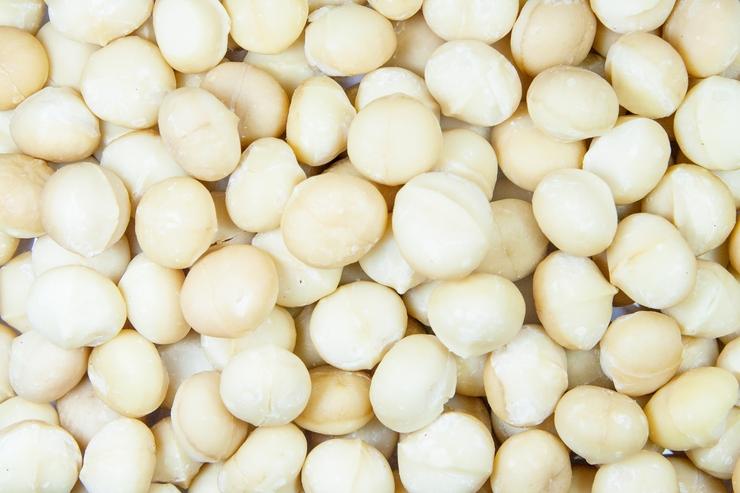 The macadamia nut is something nearly all of us view as a delicacy. Generally enjoyed from a small and expensive container, we savor each little crunchy nugget of protein. Not only are these nuts sweet and high-calorie, but they are rich in nutrients. Now as it turns out, their husks too may be a rich source of fuel as well as a building materials.
The macadamia nut is something nearly all of us view as a delicacy. Generally enjoyed from a small and expensive container, we savor each little crunchy nugget of protein. Not only are these nuts sweet and high-calorie, but they are rich in nutrients. Now as it turns out, their husks too may be a rich source of fuel as well as a building materials.
Also known as the Australia nut, a number of different macadamia species grow wild in their native land, but only two are edible. The shells are another story though in terms of usefulness, as researchers from University of Sydney are currently working on a project to parlay them into  material for 3D printing microtimber. In the ultimate demonstration of the potential for recycling materials on a massive level, the macadamia nut shells could be used, along with other material like forestry waste byproduct, in making what researchers and industry insiders refer to as ‘gradient timber panel.’
material for 3D printing microtimber. In the ultimate demonstration of the potential for recycling materials on a massive level, the macadamia nut shells could be used, along with other material like forestry waste byproduct, in making what researchers and industry insiders refer to as ‘gradient timber panel.’
While it may not be general knowledge, the macadamia nut is used for far more than delighting our tastebuds and efficiently fueling the human machine. They are currently being used as biofuel, successfully, in Queensland as macadamia nut farmers convene in a co-op to see that the shells are recycled by burning them to make heat, as well as functioning as an excellent source of garden mulch. Burning the shells to create renewable energy in the form of electricity is already helping the environment with reduction of waste in landfills, helping reduce greenhouse emissions, and more–and with the idea of using the shells for construction materials, both the recycling factor and affordability factor in another sector may be elevated to a superior level.
Researchers envision the 3D printed construction materials, to include the macadamia shells, being used in more internal areas like walls, internal screens or louvres, as well as cladding, which is a coating generally used for weather protection or basic cosmetic appearance.
The Sydney researchers, experts in architecture and engineering, foresee this new idea as a unique way to use both agricultural waste and 3D printing for innovations in sustainability that may transform the building industry on their homefront–and perhaps the rest of the world as well, eventually.
“We want to create innovative, environmentally-resilient panels that are customized to react optimally to structural stress and weather exposure of a building,” said Dr Sandra Löschke, director of architecture, design and technology and co-leader of the research team. “The work lies in the micro-layering and fusing of different 3D-printed timber compositions, to provide a unique material and geometric gradient suitable for large-scale building projects.”
This long-term project will allow the researchers to investigate a range of industrial designs and principles as they work to also incorporate the transformative technology of 3D printing into their projects.

“Timber is an important primary industry for Australia,” said co-leader, Professor Andy Dong, Warren Centre Chair for engineering innovation at the University of Sydney. “The anticipated outcomes of the research are highly significant for the forestry industry, as it could fundamentally change the way Australia produces timber-based products.”
This very interesting project that we will look forward to following will extend over several years and is partially funded by the Forestry and Wood Products Association.
Exploration into the subject of using macadamia nut shells in 3D printing may be new to the University of Sydney, but the technology is not, as recently they have been involved in a project working to 3D print cranial implants for patients involved in trauma. While the innovation itself is extremely helpful, it’s also extremely affordable, at a projected cost of $300 per 3D printed implant.
What do you think of this coupling of agricultural waste and 3D printing technology? Discuss in the 3D Printing Sustainable Timber forum over at 3DPB.com.
Subscribe to Our Email Newsletter
Stay up-to-date on all the latest news from the 3D printing industry and receive information and offers from third party vendors.
You May Also Like
Precision at the Microscale: UK Researchers Advance Medical Devices with BMF’s 3D Printing Tech
University of Nottingham researchers are using Boston Micro Fabrication‘s (BMF) 3D printing technology to develop medical devices that improve compatibility with human tissue. Funded by a UK grant, this project...
3D Printing Webinar and Event Roundup: April 21, 2024
It’s another busy week of webinars and events, starting with Hannover Messe in Germany and continuing with Metalcasting Congress, Chinaplas, TechBlick’s Innovation Festival, and more. Stratasys continues its advanced training...
3D Printing Webinar and Event Roundup: March 17, 2024
It’s another busy week of webinars and events, including SALMED 2024 and AM Forum in Berlin. Stratasys continues its in-person training and is offering two webinars, ASTM is holding a...
3D Printed Micro Antenna is 15% Smaller and 6X Lighter
Horizon Microtechnologies has achieved success in creating a high-frequency D-Band horn antenna through micro 3D printing. However, this achievement did not rely solely on 3D printing; it involved a combination...





























